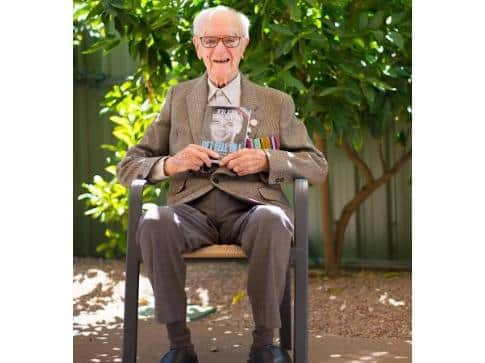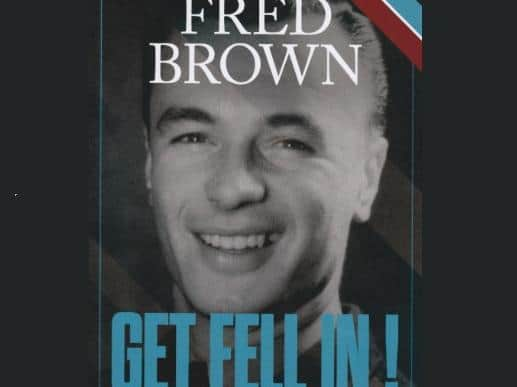Former RAF Bomber stationed in Leighton Buzzard recalls his experience of the Second World War in new book
This article contains affiliate links. We may earn a small commission on items purchased through this article, but that does not affect our editorial judgement.
and live on Freeview channel 276
The memoirs of an air force recruit in the Second World War has given details for the first time of a secret weapon deployed to defend Q Central, Leighton Buzzard’s RAF base which was the communications headquarters of Britain’s war effort.
The book which tells of the wartime experiences of Fred Brown, now 98, who was a gunner in Lancaster bombers and was subsequently shot down over Belgium begins with an account of his time guarding Leighton’s station, a vital underground nerve centre.
Advertisement
Hide AdAdvertisement
Hide AdBrown, whose book is a frank and amusing account of service life, was posted to Leighton Buzzard in November 1940.


He was met at the station and brought to the RAF station in Stanbridge Road. “What a shock, this was not a normal RAF station. We were at a Marley Tile Plant, a factory making roof tiles. A huge expanse of concrete, tiles stacked row upon row, old run down buildings, small sheds dotted about the place. Airmen walking about, aimlessly it seemed.”
He described how they were marched to an old whitewashed building saying it was some time since it had last seen a lick of paint and was coated with “the dust of ages. It was a culture shock.”
Fortunately, he says, he was posted to Dunstable to guard another secret establishment, the Met Office, which had been moved there to protect it from the London bombing.
Advertisement
Hide AdAdvertisement
Hide AdHe was billeted with local families and life was idyllic but after some months of a comparatively easy life was posted back to Leighton Buzzard.


“Leighton Buzzard was divided into two distinct areas. HQ and Signals, housed in a camouflaged area where the sun never shone through. Signals was below ground. Staffed by what seemed to be hundred of WAAFS. All who worked in this area were billeted in civvy billets or in hostels.
“We who had to defend and guard the camouflaged area, lived, or existed on Marley Tiles. The main making plant had been gutted, all equipment removed. In its place, two tier beds, row upon row of them, the bunks touching, with a narrow walkway between every other row. It was really a touch of Charles Dickens, a truly awful place. Little or no ventilation and at night, when the blackout screens were in place, no ventilation at all.
“Rats scuttled along the roof rafters. No privacy, not even in the toilets, not a door on any of the toilets, no hot water, no washbasins, only tin bowls. About 400 packed men, like sardines in a tin.”
Advertisement
Hide AdAdvertisement
Hide AdBrown then describes the duties of a his crew which using twin Lewis guns were to guard this most secret base while living in these appalling conditions.
To each gun crew was attached a member of the Parachute and Cable Unit whose job it was to deploy a secret weapon if Q Central was attacked.
For a long time the nature of the weapon was not disclosed but he later learned that the weapon was contained in a ring of boxes round the base. Each one had a charge or rocket attached to a cable at the top of which was a large parachute. The idea was to deter low flying aircraft. The cables fired high in the air would descend slowly by parachute preventing low-level attack.
This and many other details of his life at RAF Leighton Buzzard, as it was then known, and its satellite stations like Dagnall, are part of an entertaining but also disturbing account of wartime called “Get Fell In!” the RAF’s most used command.
Advertisement
Hide AdAdvertisement
Hide AdHis continuing awful experiences in Leighton Buzzard meant his long awaited posting as an aircrew gunner came as a relief.
He describes his training, his bombing runs and being shot down. He was injured but hidden by the civilian population before being caught and interrogated by the Gestapo.
His subsequently ordeals on a long march for prisoners of war to Berlin to avoid the Russian advance are a gripping and harrowing read.
For historians, however, the details about defence of Leighton Buzzard’s secret headquarters are new.
Advertisement
Hide AdAdvertisement
Hide AdA book called Q Central, by the Leighton Buzzard and District Archaeological and Historical Society published in 2014 by the History Press, has many details about what the secret headquarters did and life in the town but this is the first account of the privations of the men guarding the station against enemy attack.
Because the Germans never discovered the importance of the station the secret weapons to deter low flying dive bombers was never deployed and was withdrawn from Leighton Buzzard in 1943, so whether it actually worked no one knows.
Fred Brown met and married a Hemel Hempstead woman, Nancy Kirke, who was part of the Women's Auxiliary Air Force at RAF Leighton Buzzard.
In the 1960s he emigrated to Australia and worked as an accountant. He now lives in Adelaide. However, one of his daughters, Jane Cutler, still lives in Cheddington.
Advertisement
Hide AdAdvertisement
Hide AdShe said: "The book has been described as 'It is brilliantly written and fascinating about his time at Leighton Buzzard', 'enthralling' and 'I felt as though he was talking to me'.
"It is a story with a wide appeal: a primary source of local and war history; a war time love story, we find out what really happened in German Prisoner of War camps.
"The story of dad in Limal, near Brussels, was made into a film, of course in French.
"It was called A parachute and Two Wedding Dresses because dad's silk parachute was made into two wedding dresses. With tears in his eyes, an elderly man thanked me for the help that Britain had given Belgium in the war at the film's debut. It was all very moving."
The book is available from Amazon.